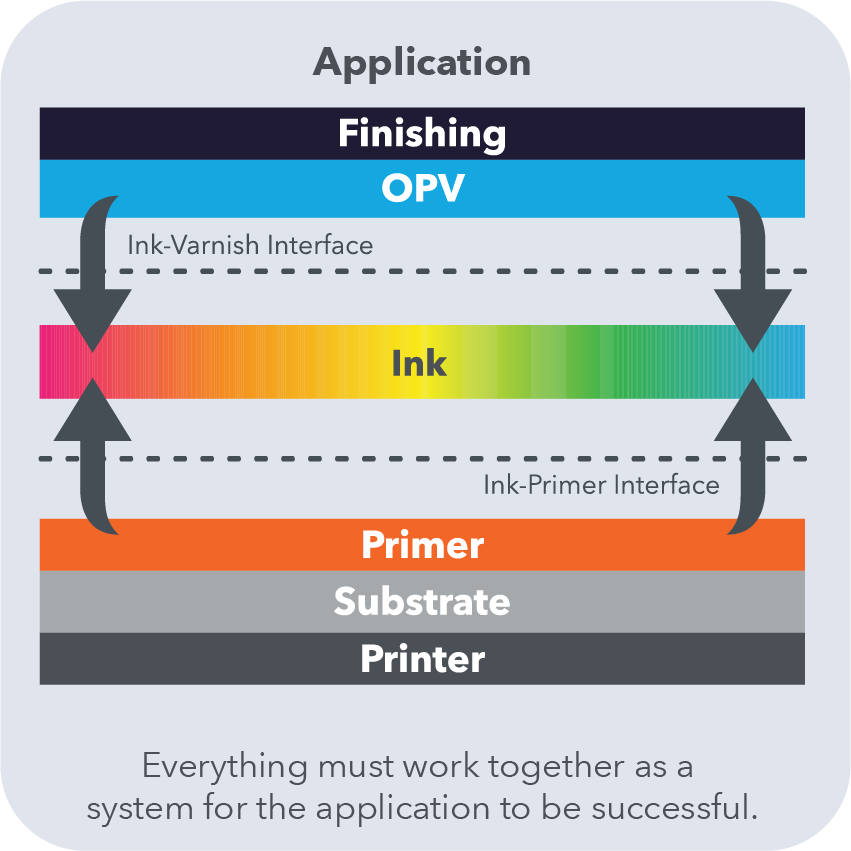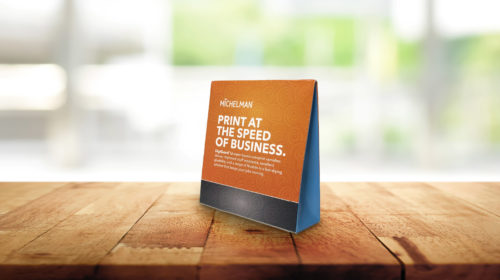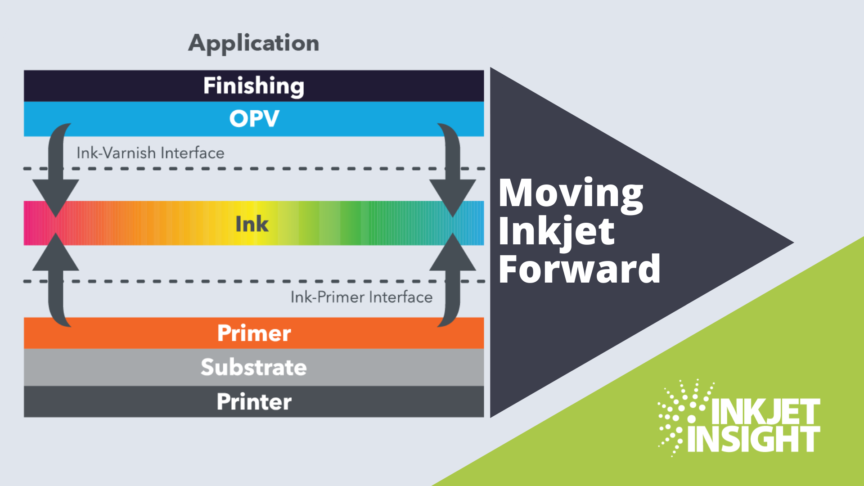Sponsored by Michelman
Inkjet printing is entering new markets spurred by improved substrate compatibility, higher speeds and expanded color gamuts. How much do you know about key breakthroughs that have enabled this growth? This article goes beyond equipment and ink to examine another critical success factor: substrates (also called media). The quality of any printed product must consider the quality of the chosen media. Substrate quality is affected by the coatings that are applied to them before or after printing: primers and overprint varnishes (OPVs). In this article, leading primer and OPV supplier, Michelman, helps us better understand this lesser explored, but critically important contributor to inkjet print quality and market penetration.
Enhancements to OEM Inkjet Systems
When we think of inkjet, we often consider print equipment design, print head selection, the ink formulation and the image quality of a sample print. While these factors are of course important, Michelman argues that inkjet success goes beyond these traditional factors that OEMs commonly consider when developing a market for inkjet penetration. Inkjet success is directly linked to substrate compatibility and the coatings that are applied to the substrate to enable that compatibility. Unfortunately, substrates are too often an afterthought in the design process.
Consider that the substrate is the base layer in an inkjet construction. Substrates and the coatings applied to them directly impact print quality, color, gloss, print protection and overall productivity. In the early days of inkjet, substrate availability limited widespread use, and therefore OEM growth. This caused OEMs to develop their own primers in order to broaden substrate availability and increase market adoption.
A primer is a coating that is applied to a substrate that bridges the performance between the substrate itself and the ink that is printed on it. A good primer keeps the ink on the surface, minimizing the amount of ink that has to be used in order to get a great print while promoting adhesion to the substrate and print longevity. Primers may be applied to substrates before an end user purchases the substrate and others are applied by the end user as either an inline or offline process.
An OPV is a clear coating that is applied over the ink to improve print durability and/or to add a special effect such as gloss. OPVs are typically applied by the printer often inline with the print process.
OEMs are experts in printer engineering and ink development. However, an OEM’s expertise may not extend to the development, or application of, primers and/or OPV coatings. Printers use many different substrates. The combinations of substrate, primer, ink, OPV, printer, printhead are nearly limitless. Media that are truly designed for the given print application, print machine and ink can be a real challenge. The level of complexity requires expertise in each area to optimize the media for a given application and print system. To achieve the right print media for the application, coating expertise is needed in addition to ink, printhead and printer expertise.
When OEMs work with a partner to optimize the media for their equipment and each end application, development can happen more quickly and efficiently. End users get a solution that is both tailored for their needs and is nearly plug and play at the time of installation. Optimizing media, equipment and application also gives OEMs the benefit of expanding the applications their machines can be used. This accelerates penetration in multiple markets. Optimized media is a benefit to the OEM, their customers and the market as a whole. A partner for primer development will consider the impact of the fluid chemistry on the entire production process. For example, some primers have been known to react with anilox application equipment increasing maintenance requirements and/or shortening the useful life of the equipment (see below). An OEM’s primer partner will control the corrosiveness of the primer on the application equipment to ensure improved print quality does not come at the cost of unplanned production shut downs or damage to equipment – both of which can be catastrophic to a printer’s business.
Damage to anilox application equipment caused by corrosive fluid chemistry. (Image courtesy of Great Northern StrataGraph)
Optimizing Media With Michelman
Michelman is well-known as an expert in the development of barrier and functional coatings, as well as digital printing-press primers and OPVs that are used in the production of consumer and industrial packaging, paper products, labels, and commercially printed materials. Operating globally, Michelman maintains production facilities in North America, Europe and Asia. Product development and technical services centers in several major global markets focus on serving the needs of both OEM and end-user printing needs.
In fact, Michelman has served the print industry for decades with primers and overprint varnishes (OPVs) for all printing applications including offset, flexography (flexo) and digital printing – both electrophotography and inkjet. In the digital printing arena, Michelman is perhaps best known for its partnership with and enablement of HP Indigo in label and flexible packaging applications. However, the company works with both OEMs and end users to truly understand the performance and in-process needs of many individual market segments. Michelman’s depth of downstream process understanding includes the markets of flexible packaging, labels, corrugated, folding carton, and commercial print. It’s the extensive knowledge of each print process, relevant range of substrates, OEM needs, downstream process requirements, end performance measures and appropriate chemistry that set Michelman apart.
Challenges for Inkjet Growth in Packaging
Michelman is excited to support the further expansion of inkjet into the growing packaging market. Smithers report The Future of Digital Print for Packaging to 2026 reveals that the Covid-19 pandemic accelerated the use of digital print in labels and packaging, driving the market to reach worldwide revenues of $21.1 billion in 2021. Led by inkjet, digital’s share of the printed label and packaging market will increase from 4.4% by value in 2020 ($18.5 billion), to 7.2% ($35.9 billion) in 2026. This is equivalent to an 11.2% compound annual growth rate (CAGR) for 2021-2026.
Just as other markets needed the right substrate availability to expand inkjet penetration, so too will packaging. One of the big challenges for establishing media availability for digitally printed packaging is that one primer does not fit all applications and OEMs. As an example, each OEM has a unique piece of printing equipment. Each model of press may use a different print head. Inks are unique to both the OEM and the printhead. Inks vary further by chemistry. For example, inks can be water-based, solvent-based, or UV curable. Substrates and their characteristics all vary widely. Is it a porous media like paper or a non-porous one like plastic. What kind of plastic is it – polyethylene (PE), polyester (PET), polypropylene (PP), biaxially oriented polypropylene (BOPP)? Ink, coating and substrate combination also affect the drying process.

If we think of the different requirements as variables in a matrix, we quickly see there are a number of combinations that must work together. The primer is commonly the bridge to deliver the desired application performance and like any good bridge, it must be designed to work with the elements on each side, substrate and ink.
Strong OEM and End User Partnerships
Michelman attributes much of its success to its enviable OEM and end user partnerships. “We developed our first inkjet primer for Memjet DuraLink pigment inks in 2017. We then took that primer and our OPVs to some end customers of larger OEMs and solved some application issues they were having with the original OEM primer and other OPVs,” says Gianluigi Rankin, Global Marketing Manager – Digital Printing with Michelman. “The key here is partnership and trust. OEMs noticed that Michelman is a strong ally to ensure a consistent and repeatable print process that delivers on end use productivity expectations,” states Rankin.
Consider how far inkjet has come; its evolution is impressive. What was once a desktop technology has evolved into commercial printing applications, to labels, and onto packaging. The technology evolution is thrilling to Dr. Molly Hladik, Manager, Global Technology, Digital Printing. “At one time, it took minutes to create a high quality 4×6 inch print. We can now do that in fractions of a second. As we watch digital print quality matching that of offset, we’re reaching levels of excellence some said were not attainable. I’m excited about future developments, particularly as we deepen our OEM partnerships and focus on designing solutions that truly meet end-user requirements. I welcome conversations with any OEM seeking improved solutions for their customers,” says Hladik.
With supply chain challenges that have included both raw material and substrate shortages combined with the people impacts of the Great Resignation, it is more important than ever for OEMs to leverage critical partnerships for fluid development that have the potential to delight their customers while expanding their business.

Wood table top on blur kitchen window with michelman pop up sign

